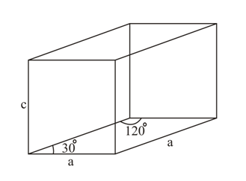Calculations Involving Unit Cell Dimensions
Calculations Involving Unit Cell Dimensions: Overview
This topic covers concepts, such as, Density of a Cubic Crystal System etc.
Important Questions on Calculations Involving Unit Cell Dimensions
Calcium crystallizes in a face centred cubic unit cell with a The density of the metal if it contains 0.1% schottky defects would be:
Copper crystallises in a face-centred cubic lattice and has a density of at The radius of a copper atom is:
[Atomic mass of
Iron has a body-centered cubic unit cell of cell edge . The density of iron is . The Avogadro number is
(Atomic mass of iron )
X-rays diffraction studies show that copper crystallizes in an FCC unit cell with cell edge of In a separate experiment, copper is determined to have a density of , the atomic mass of copper would be:
In face-centred cubic and body centred cubic whose unit cell lengths are and respectively, a metal crystallises into two cubic phases. What is the ratio of densities of and
A unit cell of sodium chloride has four formula units with an edge length of the unit cell . What is the density of sodium chloride?
Copper crystallizes in an FCC unit cell with cell edge of The density of copper is , Calculate the atomic mass of copper.
Ice crystallises in a hexagonal lattice. At the low temperature at which the structure was determined, the lattice constants were and . How many molecules are contained in a unit cell? The density of ice is at A unit cell of is shown below:

The density of iron crystal is . If the edge length of unit cell is and atomic mass is , find the number of atoms in the unit cell. (Given: Avogadro’s number = )
An element with atomic mass crystallizes in a FCC cubic lattice with edge length of . Calculate the density of the metal in .Thus, calculate the value of 'a'.
()
Lithium metal has a BCC lattice structure with edge length of unit cell is . Calculate density of the metal in . ()
Calcium metal crystallizes in a FCC cubic lattice with edge length of . Calculate the density of the metal in .
How can you calculate the atomic mass if density and the dimension of a unit cell are given of an unknown metal? Explain.
X-ray diffraction studies show that copper crystallizes in an FCC unit cell with cell edge of . In a separate experiment, copper is determined to have a density of . Calculate the atomic mass of copper.
An element has a body centred cubic (bcc) structure with a cell edge of . The density of the element is . How many atoms are present in of the element?
Niobium crystallizes in body centred cubic structure. The density in , calculate atomic radius of niobium using its atomic mass .
Silver crystallizes in FCC lattice. If edge length of the cell is and density is . Calculate the atomic mass of silver.
Determine the density of cesium chloride which crystallises in a bcc type structure with the edge length . The atomic masses of and are and respectively.
Copper crystallises into a fcc structure and the unit cell has length of edge . Calculate the density of copper if the molar mass of is
Aluminum crystallizes in a cubic close packed structure. Its metallic radius is . What is the length of the side of the unit cell?
